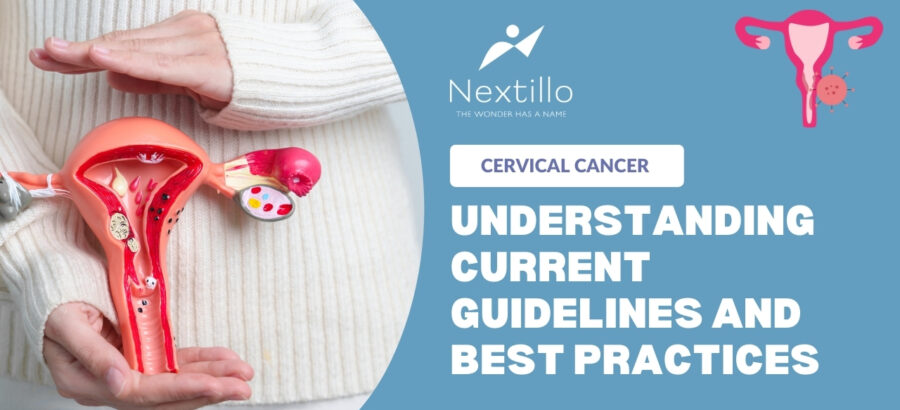What is cervical cancer?
It is the second most common cancer in India yet not popular among females. It originates in the cells lining the cervix in the lower part of the uterus that connects to the vagina. Cervical cancer develops slowly,
Cervical Cancer Screening: Current Guidelines and Practices
which often starts with precancerous changes in the cells of the cervix.
Why cervical cancer screening and awareness among women is important!
Cervical cancer develops slowly, which usually starts with precancerous changes in the cells of the cervix. These changes can be identified through screening, which significantly reduces the likelihood of the cancer progressing to its invasive form. Early detection through cervical cancer screening is a vital tool in reducing both the incidence and mortality associated with this disease. This blog helps every woman to know about current guidelines for cervical cancer screening, the evolution of screening methods, and best practices that can empower women to take control of their health.
Let’s discuss what are the causes and symptoms of cervical cancer
The primary cause of cervical cancer is human papillomavirus (HPV). HPV is a common sexually transmitted infection with many different types, but only certain strains, such as HPV-16 and HPV-18, are linked to cervical cancer.
Risk Factors
- Early sexual activity
- Multiple sexual partners
- Weakened immune system
- Smoking
- Long-term use of oral contraceptives
- Having many children
Symptoms of Cervical Cancer
In its early stages, cervical cancer may not show any noticeable symptoms. As the disease progresses, symptoms arrive
- Abnormal vaginal bleeding
- Unusual vaginal discharge
- Pain during intercourse
- Pelvic pain
The Evolution of Cervical Cancer Screening
Cervical cancer screening has made significant progress over the years. It all started with the Pap smear examination in the 1940s it’s a test where doctors collect cells from the cervix to check for any abnormal changes in cells. This test became an important part of healthcare and it has helped in saving many lives. Tests like the Pap smear and HPV testing have been shown to reduce cervical cancer deaths by up to 70%.
While the Pap smear is vital for detecting abnormal cells, it’s not perfect and can sometimes miss abnormal cells, especially in younger women under 30. This is where the HPV test comes in. HPV, a virus linked to cervical cancer, can be detected through this test, and it helps identify women who are at higher risk. By combining HPV testing with the Pap smear, doctors can better detect at-risk individuals, catch problems earlier, and reduce unnecessary treatments and ultimately preventing cancer before it even begins.
most frquently asked question is that What is the right time or right age to get screened for cervical cancer?
According to USPSTF and ACS
At age 21- According to USPSTF 21 is the right age to get yourself screened (Pap test) even if you are sexually active or not and this is followed by every 3 years till age 29 years.
From age 30 to 65 years- if you belong to this age group screening is done by one of the following three methods.
- HPV test every 5 years
- HPV/Pap cotest every 5 years
- Pap tests every 3 years
Following are the conditions which requires more frequent screenings
- Week immune system
- HIV positive female
- Exposure of the medicine diethylstilbestrol.
- Previous history of cervical cancer
- Abnormal cervical screening or biopsy test results.
According to the recent updates made by ACS, there are few changes in the screening guidelines
Screening is started at the age of 25 and from 25 to 29 years it is done by
- HPV test every 5 years is mostly preferred.
- HPV/Pap cotest every 5 years
- Pap tests every 3 years
From the age 30 to 65
- HPV test every 5 years is mostly preferred.
- HPV/Pap cotest every 5 years
- Pap tests every 3 years
At age 65 or older
There is no need for screening if there is no abnormality detected in previous screenings.
Challenges normal person face in cervical cancer screening
- Women who are residing in rural areas and in low socioeconomic status are having lack of screening facilities.
- The fear, society stigma and discomfort of pelvic examination among women is one of the major drawbacks in cervical cancer screening.
- Screening procedure is costly
- Lack of awareness
Question arises how can we prevent cervical cancer?
- HPV Vaccination: it’s a game changer as in most of the cases of cervical cancer HPV is the main culprit.
- safe sexual practices limiting the sexual partners and use of barriers can reduce it.
- Regular screening is very important as it helps to detect the cancer in an early stage.
- Smoking reduces the risk associated with cervical cancer.
Stages of Cervical Cancer
Cervical cancer is classified into stages based on the extent of the disease:
- Stage 0: Precancerous cells present.
- Stage I: Cancer is present only in the cervix.
- Stage II: Cancer has spread beyond the cervix but not to the pelvic wall or lower vagina.
- Stage III: Cancer has spread to the pelvic wall, lower vagina or causing kidney problems.
- Stage IV: Cancer has spread to other organs like the bladder, rectum or distant organs.
Treatment Options
- Surgery: Removal of cancerous tissue, which includes procedures like hysterectomy.
- Radiation Therapy: High-energy radiations are used to kill cancer cells.
- Chemotherapy: Use of specific drugs to kill cancer cells.
- Targeted Therapy: Drugs that target specific cancer cell by targeting on cell mechanism to divide.
- Immunotherapy: it is used to increase the body immune system to fight cancer.






